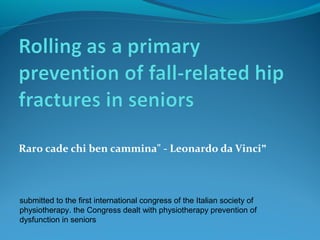
Rolling as a primary prevention of fall related hip fractures in seniors - abstract
- 1. "Raro cade chi ben cammina" - Leonardo da Vinci submitted to the first international congress of the Italian society of physiotherapy. the Congress dealt with physiotherapy prevention of dysfunction in seniors
- 2. World-wide projection of Hip fractures in seniors suggest more than 60 million incidents annually in 2050 [1]. 90% of hip fractures in seniors result from falls [2,3], mostly from sideways falls [4] , landing with direct impact or in proximity to the greater trochanter, which increase the risk by 30- folds [5]. Even when implementing a fall-prevention program the risk of fall can not be eliminated. fall techniques can decrease the impact forces at the hip during sideways fall [6], thus seniors should learn how to fall in a way that minimize the risk of Fall-related injury. Although the main biomechanics factor that initiates a fall in seniors is known, we do know that real-life lateral falls involve three-dimensional motions, and it is suggested that posterior-lateral fall has the highest risk of hip fracture [7], rendering previous studies that tested lateral falls strictly in the frontal plane [8] non-practical in real- life fall. As B. E. Groen 2010 indicated that martial arts (MA) fall techniques may be trainable in seniors [9] in some cases also with osteoporosis [10], yet a model that indicates how to fall most properly is absent.
- 3. This current study makes an analysis of simulated lateral fall into rolling, in order to create a set of exercise that can be used to teach seniors how to roll in order to decrease the risk of injury from a fall. Rolling techniques are a Whole-body movement strategies prior to impact that were borrowed from Martial arts (Aikido), where there is a constant necessity to fall with grace, thus avoiding impact forces in general and at the hip specifically. A Video registration of a Martial art expert was taken in the frontal and Sagittal planes. The techniques that were examined are 1. Aikikai semi- backroll in sagittal plane (A-SB-sg), 2.Aikikai semi-backroll from Postero- lateral fall (A-SB-pl), 3.Aikikai semi-backroll from Antero-lateral fall (A-SB- al), 3.Aikikai semi-backroll from lateral fall (A-SB-l).
- 4. A simplified model of the rolling act was generated and the phases of the rolling [Fig1] and their reference parameters were extracted. The simulated falls were in three direction 45º, 135º and 180º that is hypothesized to transfer to lateral fall, increasing the risk of a hip fracture. This spectrum was defined as the F-angle [Fig. 2]. Lack of experience in motor exploring the F-angle aggravates the chances to initiated appropriate stepping reaction to avoid the fall or the fall mechanics. Vulnerability of the F-angle is presumed from the fact that spatial sensibility is more difficult in diagonals and also the skeleton structure stability is weaker in these directions. As a result from the rolling analysis, a set of exercise was developed to emphasize the reference parameters of each of the phases of the rolling, that a deviation from these parameters will result with non-ideal roll. The exercise are propaedeutic to: the stepping reaction to improve the preliminary phase of loading response, trunk orientation prior to impact where the angularity of the trunk at impact must be perpendicular to the floor (TS0) in the sagittal plane and 70º in the frontal plane, and for each of the phases of the rolling scheme.
- 5. Figure [1]: Angle “F” - Possible angles projection that can result in a lateral fall Anterior Posterior Lateral F 315° 225° 45° 135°
- 6. Figure [2] Figure stick - Biomechanics of Martial Arts semi-rolling in sagittal plane, extracted from video of a MA expert volunteer T0=0 ms T9=1350 ms AI DxSostegno 2x AI AI Sx + sacro Tronco Sospensione +sup. Dorsi fles. Cresta tibiale noAI Sx AI DX eccentrica Non sostegno mantenere posizione Tronco Asse verticale Flessione ant. Flessiome forzata Periodo orientamento Decelerazione Flessione globale
- 7. [1] Cooper C, Campion G, Melton LJ III (1992) Hip fractures in the elderly: a world-wide projection. Osteoporos Int 2(6):285–289 [2]. Grisso JA, Kelsey JL, Strom BL, Chiu GY, Maislin G, O’Brien LA, Hoffman S, Kaplan F (1991) Risk factors for falls as a cause of hip fracture in women. The Northeast Hip Fracture Study Group. N Engl J Med 324:1326–1331. [3]. Cummings SR, Nevitt MC (1989) A hypothesis: The causes of hip fractures. J Gerontol 44:M107–M111. [4]. Wei TS, Hu CH, Wang SH, Hwang KL (2001) Fall characteristics, functional mobility and bone mineral density as risk factors of hip fracture in the community-dwelling ambulatory elderly. Osteoporos Int, 12:1050-1055. [5]. Robinovitch sn, (2003) Strategies for Avoiding Hip Impact During Sideways Falls. Journal Bone and Mineral Research Volume 18, Number 7 [6]. Groen BE, Weerdesteyn V, Duysens J (2007) Martial arts fall techniques decrease the impact forces at the hip during sideways falling. J Biomech,40(2):458-62 [7]. Nankaku M, (2005) Evaluation of hip fracture risk in relation to fall direction. Osteoporos Int. 16: 1315–1320, February [8]. M. Sabick (1999) Active responses decrease impact forces at the hip and shoulder in falls to the side. Journal of Biomechanics 32, 993-998 [9]. B. E. Groen (2008) Martial arts fall training to prevent hip fractures in the elderly. Osteoporos Int. 21:215-221 [10]. B.E. Groen (2010) Could Martial arts fall training be safe for persons with osteoporosis?: a feasibility study. BMC Research Notes 3:111 References